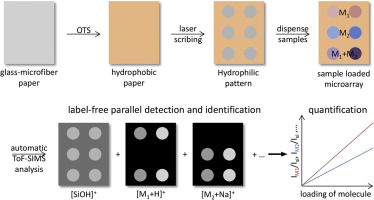当前位置:
X-MOL 学术
›
Anal. Chim. Acta
›
论文详情
Our official English website, www.x-mol.net, welcomes your
feedback! (Note: you will need to create a separate account there.)
Integration of paper-based microarray and time-of-flight secondary ion mass spectrometry (ToF-SIMS) for parallel detection and quantification of molecules in multiple samples automatically
Analytica Chimica Acta ( IF 5.7 ) Pub Date : 2018-04-01 , DOI: 10.1016/j.aca.2017.12.017 Kuo-Jui Chu , Po-Chun Chen , Yun-Wen You , Hsun-Yun Chang , Wei-Lun Kao , Yi-Hsuan Chu , Chen-Yi Wu , Jing-Jong Shyue
Analytica Chimica Acta ( IF 5.7 ) Pub Date : 2018-04-01 , DOI: 10.1016/j.aca.2017.12.017 Kuo-Jui Chu , Po-Chun Chen , Yun-Wen You , Hsun-Yun Chang , Wei-Lun Kao , Yi-Hsuan Chu , Chen-Yi Wu , Jing-Jong Shyue

|
With its low-cost fabrication and ease of modification, paper-based analytical devices have developed rapidly in recent years. Microarrays allow automatic analysis of multiple samples or multiple reactions with minimal sample consumption. While cellulose paper is generally used, its high backgrounds in spectrometry outside of the visible range has limited its application to be mostly colorimetric analysis. In this work, glass-microfiber paper is used as the substrate for a microarray. The glass-microfiber is essentially chemically inert SiOx, and the lower background from this inorganic microfiber can avoid interference from organic analytes in various spectrometers. However, generally used wax printing fails to wet glass microfibers to form hydrophobic barriers. Therefore, to prepare the hydrophobic-hydrophilic pattern, the glass-microfiber paper was first modified with an octadecyltrichlorosilane (OTS) self-assembled monolayer (SAM) to make the paper hydrophobic. A hydrophilic microarray was then prepared using a CO2 laser scriber that selectively removed the OTS layer with a designed pattern. One microliter of aqueous drops of peptides at various concentrations were then dispensed inside the round patterns where OTS SAM was removed while the surrounding area with OTS layer served as a barrier to separate each drop. The resulting specimen of multiple spots was automatically analyzed with a time-of-flight secondary ion mass spectrometer (ToF-SIMS), and all of the secondary ions were collected. Among the various cluster ions that have developed over the past decade, pulsed C60+ was selected as the primary ion because of its high secondary ion intensity in the high mass region, its minimal alteration of the surface when operating within the static-limit and spatial resolution at the ∼μm level. In the resulting spectra, parent ions of various peptides (in the forms [M+H]+ and [M+Na]+) were readily identified for parallel detection of molecules in a mixture. By normalizing the ion intensity of peptides with respect to the glass-microfiber matrix ([SiOH]+), a linear calibration curve for each peptide was generated to quantify these components in a mixture.
中文翻译:

纸基微阵列和飞行时间二次离子质谱 (ToF-SIMS) 的集成,用于自动并行检测和定量多个样品中的分子
凭借其低成本的制造和易于修改的特点,纸基分析设备近年来发展迅速。微阵列允许以最少的样品消耗自动分析多个样品或多个反应。虽然通常使用纤维素纸,但其在可见范围之外的光谱测定中的高背景限制了其主要应用于比色分析。在这项工作中,玻璃微纤维纸被用作微阵列的基材。玻璃微纤维本质上是化学惰性的 SiOx,这种无机微纤维的较低背景可以避免各种光谱仪中有机分析物的干扰。然而,通常使用的蜡印无法润湿玻璃微纤维以形成疏水屏障。因此,要制备疏水-亲水图案,玻璃微纤维纸首先用十八烷基三氯硅烷 (OTS) 自组装单层 (SAM) 改性,使纸具有疏水性。然后使用 CO2 激光划线器制备亲水性微阵列,该划线器选择性地去除具有设计图案的 OTS 层。然后将 1 微升不同浓度的肽水滴分配到圆形图案内,其中 OTS SAM 被去除,而带有 OTS 层的周围区域用作分隔每一滴的屏障。使用飞行时间二次离子质谱仪 (ToF-SIMS) 自动分析得到的多点样本,并收集所有二次离子。在过去十年发展起来的各种簇离子中,脉冲 C60+ 被选为初级离子,因为它在高质量区域具有高次级离子强度,当在静态极限和~μm 水平的空间分辨率内操作时,它的表面变化最小。在得到的光谱中,各种肽的母离子(以 [M+H]+ 和 [M+Na]+ 的形式)很容易被识别出来,用于平行检测混合物中的分子。通过相对于玻璃-微纤维基质 ([SiOH]+) 对肽的离子强度进行归一化,生成了每个肽的线性校准曲线,以量化混合物中的这些成分。各种肽的母离子(以 [M+H]+ 和 [M+Na]+ 的形式)很容易被识别出来,用于平行检测混合物中的分子。通过相对于玻璃-微纤维基质 ([SiOH]+) 对肽的离子强度进行归一化,生成了每个肽的线性校准曲线,以量化混合物中的这些成分。各种肽的母离子(以 [M+H]+ 和 [M+Na]+ 的形式)很容易被识别出来,用于平行检测混合物中的分子。通过相对于玻璃-微纤维基质 ([SiOH]+) 对肽的离子强度进行归一化,生成了每个肽的线性校准曲线,以量化混合物中的这些成分。
更新日期:2018-04-01
中文翻译:

纸基微阵列和飞行时间二次离子质谱 (ToF-SIMS) 的集成,用于自动并行检测和定量多个样品中的分子
凭借其低成本的制造和易于修改的特点,纸基分析设备近年来发展迅速。微阵列允许以最少的样品消耗自动分析多个样品或多个反应。虽然通常使用纤维素纸,但其在可见范围之外的光谱测定中的高背景限制了其主要应用于比色分析。在这项工作中,玻璃微纤维纸被用作微阵列的基材。玻璃微纤维本质上是化学惰性的 SiOx,这种无机微纤维的较低背景可以避免各种光谱仪中有机分析物的干扰。然而,通常使用的蜡印无法润湿玻璃微纤维以形成疏水屏障。因此,要制备疏水-亲水图案,玻璃微纤维纸首先用十八烷基三氯硅烷 (OTS) 自组装单层 (SAM) 改性,使纸具有疏水性。然后使用 CO2 激光划线器制备亲水性微阵列,该划线器选择性地去除具有设计图案的 OTS 层。然后将 1 微升不同浓度的肽水滴分配到圆形图案内,其中 OTS SAM 被去除,而带有 OTS 层的周围区域用作分隔每一滴的屏障。使用飞行时间二次离子质谱仪 (ToF-SIMS) 自动分析得到的多点样本,并收集所有二次离子。在过去十年发展起来的各种簇离子中,脉冲 C60+ 被选为初级离子,因为它在高质量区域具有高次级离子强度,当在静态极限和~μm 水平的空间分辨率内操作时,它的表面变化最小。在得到的光谱中,各种肽的母离子(以 [M+H]+ 和 [M+Na]+ 的形式)很容易被识别出来,用于平行检测混合物中的分子。通过相对于玻璃-微纤维基质 ([SiOH]+) 对肽的离子强度进行归一化,生成了每个肽的线性校准曲线,以量化混合物中的这些成分。各种肽的母离子(以 [M+H]+ 和 [M+Na]+ 的形式)很容易被识别出来,用于平行检测混合物中的分子。通过相对于玻璃-微纤维基质 ([SiOH]+) 对肽的离子强度进行归一化,生成了每个肽的线性校准曲线,以量化混合物中的这些成分。各种肽的母离子(以 [M+H]+ 和 [M+Na]+ 的形式)很容易被识别出来,用于平行检测混合物中的分子。通过相对于玻璃-微纤维基质 ([SiOH]+) 对肽的离子强度进行归一化,生成了每个肽的线性校准曲线,以量化混合物中的这些成分。











































 京公网安备 11010802027423号
京公网安备 11010802027423号